SUNGKYUNKWAN UNIVERSITY (SKKU), SEOUL, KOREA
- Lithium-ion Battery with 5x Capacity Developed
- The Instant a Water Drop Evaporates Has Been Captured
- Restraining Fat Stem Cell Differentiation to Avoid Child Obesity
- Finding New Protein to Cure Obesity and Metabolic Diseases
- 'The World Class High-Performance Photodetector' Has Finally Been Created
- A Conductive Nano-Bio Composite 'Fullerene-Protein' Structure in a Regular Arrangement

New lithium-ion batteries have been invented that have five-times the capacity as current ones opening a new path for the development of batteries used in electric devices such as smart phones and notebooks.
A joint research team that includes Prof. Ji Man Kim of Sungkyunkwan University's Department of Chemistry and Prof. Won Sub Yoon of the Department of Energy Science discovered that if they use molybdenum oxide combined with a nano constitution to create a cathode, they can increase the capacity of a battery by five times.
The research team was the first to investigate the mechanism of lithium being saved in 'metallic cluster' form in molybdenum oxide. Professor Ji Man Kim said, "The newly discovered mechanism overturned the established theory related to lithium-ion batteries and is the result of several years of experiments and modifications. We can now develop new electrode material for lithium-ion batteries that surpass the limit of the preexisting theory".
The results of the research were published in 'Nature Communications' on March 22, 2016.
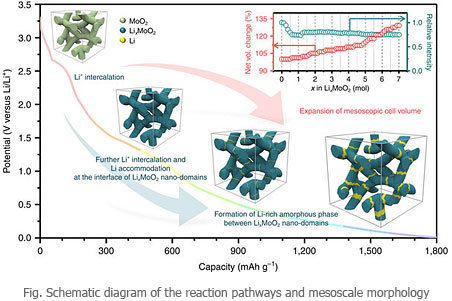
Find more information at:
http://www.nature.com/ncomms/2016/160322/ncomms11049/full/ncomms11049.html

A research group led by Professor Byung Mook Won from Sungkyunkwan University's Faculty of New Materials Engineering was successful in capturing a water drop's evaporation for 0.3 seconds. The head of the group announced on April 4th, "We have initially made a success in watching the process of evaporation of water drop 214fL in volume. The abbreviation in this case 'fL' denotes one liter over a quadrillion.
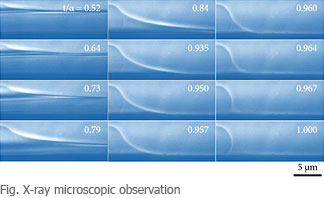 The group captured the scene of the process in which a water drop becomes invisible as it is squeezed between micro particles by using an 'Ultrahigh Speed X-ray Nano Picture Beam Line' that belongs to Pohang Laboratory. The result from the study shows that the internal pressure of water drop is 0.6, which is lower than that of the air. The speed of the evaporation was one-sixth the speed a normal water drop evaporates. As a result, the hypothesis that the speed of evaporation of a squeezed water drop may be slower than usual has been proved.
The group captured the scene of the process in which a water drop becomes invisible as it is squeezed between micro particles by using an 'Ultrahigh Speed X-ray Nano Picture Beam Line' that belongs to Pohang Laboratory. The result from the study shows that the internal pressure of water drop is 0.6, which is lower than that of the air. The speed of the evaporation was one-sixth the speed a normal water drop evaporates. As a result, the hypothesis that the speed of evaporation of a squeezed water drop may be slower than usual has been proved.
Prof. Won says, "The evaporation slows down as it becomes harder for the vapor to escape from the water drop on account of the lower internal pressure compared to the surrounding air. This discovery will contribute to the understanding of the formation of clouds and the control of nanoparticles.
The research group's findings have been posted on Scientific Reports in cooperation with Nature.
Find more information at:
http://www.nature.com/articles/srep22232

Korean researchers have figured out the mechanism for the cause of obesity. This contribution can be led to developing new obesity-curing drugs, especially in child obesity.
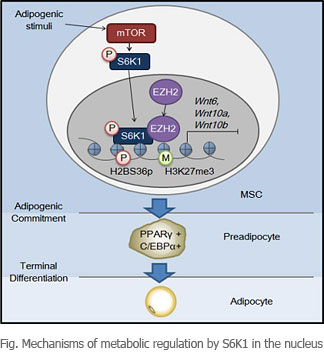 Last year, it is estimated by the CDC that 10% of children and teenagers are obese. Once the fat cell has been created, it never vanishes causing adult obesity.
Chile obesity is mainly caused by increasing fat cells. It often leads to adult obesity and increases possibility of hypertension or diabetes. Local researchers presented in the acdemic journal that they found the mechanism how protein induces fat cells to cause obesity. 'S6K1', a signal transmitter in the body, was dyed in green to observe the fat stem cells. S6K1 is activated by food intake, causing excessive fat cells. It seems that a new medicine can be developed to prevent S6K1.
Last year, it is estimated by the CDC that 10% of children and teenagers are obese. Once the fat cell has been created, it never vanishes causing adult obesity.
Chile obesity is mainly caused by increasing fat cells. It often leads to adult obesity and increases possibility of hypertension or diabetes. Local researchers presented in the acdemic journal that they found the mechanism how protein induces fat cells to cause obesity. 'S6K1', a signal transmitter in the body, was dyed in green to observe the fat stem cells. S6K1 is activated by food intake, causing excessive fat cells. It seems that a new medicine can be developed to prevent S6K1.
Prof. Han, Jung-hwan at Sungkyunkwan University said "If we can restrain S6K1 from going into the nucleus, it will be a safe medicine to cure child obesity problem."
In fact, the mouse that had restrained S6K1 weighted less than half of the mouse without restraint. Also, visceral fat was only 1/4.
If it is possible to prevent excessive differentiation from the stem cell to fat cell, the stem cell can differentiate into the bone or muscle, lessening the possibility of obesity.
Find more information at:
http://www.cell.com/molecular-cell/fulltext/S1097-2765(16)00189-1

On May 17th, Sungkyunkwan University announced that the research paper on "PRDM4 induction by the small molecule butein promotes white adipocyte browning", written by Professor Park, Kye Won and graduate student Song, No Joon, has been published on the Nature Chemical Biology, on May 9th. The research team explained that this research could suggest a new way to cure obesity and metabolic diseases.
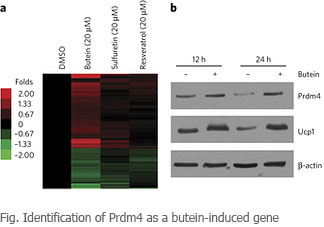 They verified that Butein(substance from lacquer tree) converts white adipocyte to brown adipocyte, through cell model. Also, they found a new protein called PRDM4, which converts white adipocyte to brown adipocyte. This PDRM4 is notable to suggest new way to develop energy metabolism cures.The research mentioned that obese cure for now causes loss in appetite, absorption, and increase in metabolism. Loss in appetite has brain stability issue, while loss in absorption has hygiene or social problems.
They verified that Butein(substance from lacquer tree) converts white adipocyte to brown adipocyte, through cell model. Also, they found a new protein called PRDM4, which converts white adipocyte to brown adipocyte. This PDRM4 is notable to suggest new way to develop energy metabolism cures.The research mentioned that obese cure for now causes loss in appetite, absorption, and increase in metabolism. Loss in appetite has brain stability issue, while loss in absorption has hygiene or social problems.
Find more information at:
http://www.nature.com/nchembio/journal/vaop/ncurrent/full/nchembio.2081.html

The new technology in two-dimensional nano semiconductor has just been developed. It surprisingly raises the response factor of light in the semiconductor and upgrades the performance as a result. The research group conducted by Prof. Jin hong Park at SUNGKYUNKWAN UNIVERSITY announced on May 26th that his team has created the new technology of response factor of light in two-dimensional nano semiconductor by utilizing the technology of n-type doping and arranging different materials in vertical.
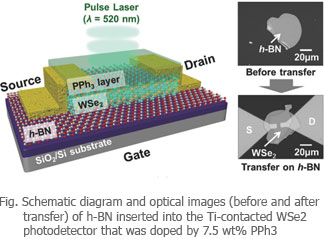 Two-dimensional nano semiconductor is known as thin as paper and for the electronical, mechanical and optical characteristic. The invention of the product is remarkable in the market due to its applicability on the flexible and transparent material of electronic equipment such as a smart phone, tablet computer and smart watch. In usual circumstance, two-dimensional semiconductor implies only one of two features, n-type with a lot of electron or p-type with a lot of holes, which cause a few of difficulties for using. This is why the team employed the doping technology in which triphenylphosphine is thinly laminated on the surface of WSe2. In result, they developed n-type photodetector making use of n-type doping technology. The development precedes all related studies, proving its superiority in the aspect of response factor of light than that of p-type photodetector. The research team also dramatically raised the response factor of light by piling up two-dimensional nano semiconductor in vertical on two-dimensional electric insulation material called h-BN. It is formally stated that the outcome is 25 times higher than that of the element of photodetector based on MoS2. The response factor of light can be found from very slight light intensity, the team added. Moreover, the outcome shows that the response factor of light of the invented photodetector is five times higher than that of preceding p-type WSe2 that is inapplicable with the doping technology as well as a million times better than the photodetector based on silicon and gallium arsenide that are the main materials for making semiconductor.
Two-dimensional nano semiconductor is known as thin as paper and for the electronical, mechanical and optical characteristic. The invention of the product is remarkable in the market due to its applicability on the flexible and transparent material of electronic equipment such as a smart phone, tablet computer and smart watch. In usual circumstance, two-dimensional semiconductor implies only one of two features, n-type with a lot of electron or p-type with a lot of holes, which cause a few of difficulties for using. This is why the team employed the doping technology in which triphenylphosphine is thinly laminated on the surface of WSe2. In result, they developed n-type photodetector making use of n-type doping technology. The development precedes all related studies, proving its superiority in the aspect of response factor of light than that of p-type photodetector. The research team also dramatically raised the response factor of light by piling up two-dimensional nano semiconductor in vertical on two-dimensional electric insulation material called h-BN. It is formally stated that the outcome is 25 times higher than that of the element of photodetector based on MoS2. The response factor of light can be found from very slight light intensity, the team added. Moreover, the outcome shows that the response factor of light of the invented photodetector is five times higher than that of preceding p-type WSe2 that is inapplicable with the doping technology as well as a million times better than the photodetector based on silicon and gallium arsenide that are the main materials for making semiconductor.
Prof. Park said, "We anticipate upgrading the characteristic of response factor of light further so that it can dedicate to the development of photoelectric element and of optical measurement sensor industry. The research was sponsored by Korean Ministry of Science and posted on "Advanced Materials" on April 23rd, which is an international scientific magazine about nano material studies.
Find more information at:
http://onlinelibrary.wiley.com/doi/10.1002/adma.201600032/full

A Korean research team found a three-dimensional structure of a fullerene-protein (COP) composite by using a self-assembly protein.
On June 6th, Dr. Yongho Kim, a professor at Sungkyungwan University, announced that he made a fullerene-protein (COP) composite crystallize by using a 'de novo protein design' which created a protein with a new structure that has not existed before.
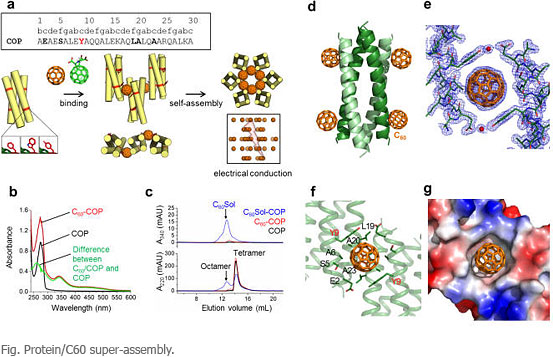
This composite shows that it is possible for fullerene to be a regular arrangement with a self-assembled protein and can change into conductive crystal. Fullerene is a ball-shaped molecule composed of over 60 strongly connected carbon atoms. It is a representative nanomaterial that has many uses such as lubricants, catalysts for industrial use, and medical supplies. It can also be used to aid in treatment of diseases like Alzheimer's as well as in medical parts related to free radicals. However, there is difficulty using it because it does not dissolve into water well and there is a self-gathering phenomenon.
Mr. Kim's team discovered a high-resolution three-dimensional fullerene-protein (COP) composite with X-ray crystallography that indicates molecule-level structure for the first time in the world. This technique analyzes an X-ray diffraction pattern of protein crystals to reveal high-resolution three-dimensional structures at the molecular level with a calculation of phase information and an electron-density map.
Prof. Kim said, "I suggested the first model which arranges fullerene regularly into a protein design. It is expected to be used in an important technique to develop new conductive materials based on protein and novel biomaterial."
The results of the study were published in Nature Communications along with Nature Scientific Journal's online edition on April 27th.
Find more information at:
http://www.nature.com/ncomms/2016/160426/ncomms11429/full/ncomms11429.html#f1




















